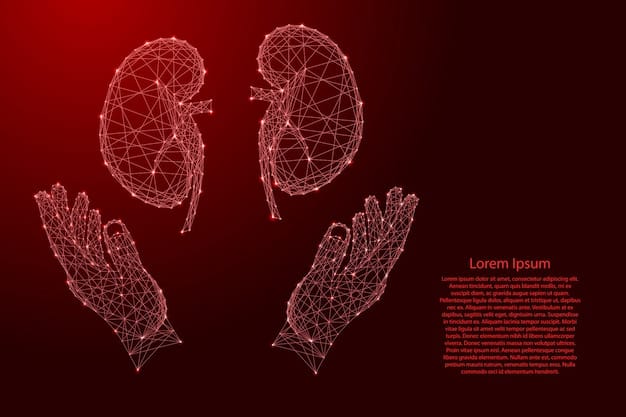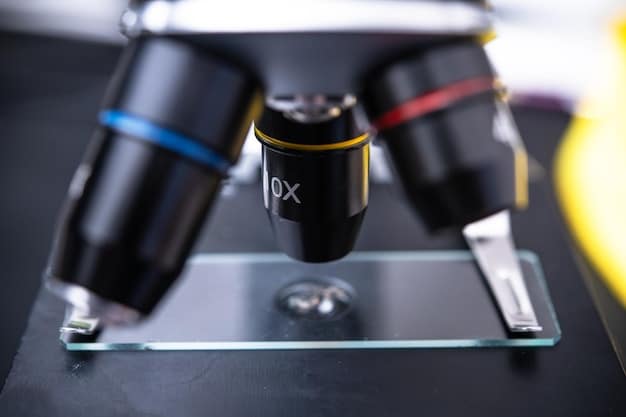Bioprinting Human Organs: When Will We See US Transplants?

Bioprinting human organs holds immense promise for revolutionizing healthcare, particularly in addressing the critical shortage of donor organs, but the widespread availability of **bioprinted organs** for transplantation in the US still faces significant technological, regulatory, and ethical hurdles, potentially delaying their routine use for a decade or more.
The prospect of bioprinting human organs offers a beacon of hope for millions awaiting life-saving transplants. But when will we realistically see these bioprinted organs successfully transplanted in the US, offering a viable solution to the critical organ shortage? Let’s delve into the science, challenges, and timelines involved, exploring when this futuristic technology might become a present-day reality.
Bioprinting: A Glimpse into the Future of Organ Replacement
Bioprinting represents a groundbreaking convergence of 3D printing technology and tissue engineering, offering the potential to create functional human tissues and organs. This innovative approach could revolutionize medicine by providing customized organs for transplantation, eliminating the reliance on donor organs and reducing the risks of rejection.
The Bioprinting Process: An Overview
The bioprinting process involves creating a 3D structure, layer by layer, using a bio-ink composed of living cells, biomaterials, and growth factors. This bio-ink is carefully deposited to create a specific tissue or organ structure, mimicking its natural complexity.
Key Components of Bioprinting
- Bio-ink: The fundamental material consisting of cells, biomaterials, and growth factors.
- 3D Printer: A specialized printer designed to precisely deposit bio-ink.
- Bioprinting Software: Software that designs, plans, and controls the printing process.
While still in its early stages, bioprinting has demonstrated remarkable progress, producing functional tissues like skin, cartilage, and even small-scale organs. However, creating complex organs with intricate vascular networks and cellular structures remains a significant challenge.

Bioprinting is not just about creating cells; it’s about creating functional, living tissues. This requires a deep understanding of biology, materials science, and engineering Working together to achieve results.
The Hurdles to Bioprinted Organ Transplants
While the potential of bioprinting is undeniable, several significant challenges must be overcome before we witness successful transplants of bioprinted organs in the US. These challenges span technological, regulatory, and ethical domains.
Technical Obstacles in Bioprinting
Creating functional, transplantable organs requires more than just printing cells. It demands intricate vascular networks to ensure proper nutrient delivery and waste removal. This is a major technological hurdle.
Regulatory Pathways for Bioprinted Organs
- FDA Approval: Bioprinted organs must undergo rigorous testing and approval processes by the Food and Drug Administration (FDA).
- Clinical Trials: Extensive clinical trials are necessary to evaluate the safety and efficacy of bioprinted organs in humans.
- Ethical Considerations: Addressing ethical concerns related to the creation and use of bioprinted organs is crucial.
The creation of a fully functional organ is an accomplishment, getting them approved is a whole other challenge with lots of hurdles and regulatory pathways. In the US, organizations like the FDA must be adressed.
Progress and Milestones in Bioprinting
Despite the challenges, the field of bioprinting has witnessed remarkable progress in recent years. Researchers have achieved significant milestones in creating functional tissues and simple organs.
Successful Bioprinting of Tissues
Several research groups have successfully bioprinted functional skin, cartilage, and bone tissues. These tissues have shown promise in wound healing, reconstructive surgery, and drug testing applications.
Advancements in Bioprinting Complex Structures
- Vascularization: Researchers have developed innovative techniques to create vascular networks within bioprinted tissues, crucial for organ functionality.
- 3D Scaffolds: The use of biocompatible scaffolds provides structural support for cells during the bioprinting process.
- Cell Differentiation: Controlling cell differentiation to create specific tissue types is crucial for organ development.
These success stories encourage the development of this technology, showing that this industry is constantly growing with new and improved techniques.

The Role of Research and Investment
Continued research and investment are crucial for accelerating the development of bioprinting technology. Collaboration between academia, industry, and government agencies is essential for driving innovation and overcoming existing challenges.
Government Funding and Initiatives
Government agencies like the National Institutes of Health (NIH) play a vital role in funding bioprinting research. Strategic initiatives can facilitate collaboration and accelerate the development of bioprinting technologies.
The Role of Private Sector Investment
- Venture Capital: Investment from venture capital firms can fuel the growth of bioprinting companies and support commercialization efforts.
- Pharmaceutical Partnerships: Collaboration with pharmaceutical companies can accelerate drug development and personalized medicine approaches.
- Philanthropic Support: Philanthropic organizations can provide funding for innovative research projects and educational initiatives.
Many of the most innovative ideas come to life not through the research of individuals alone but through collaboration and teamwork.
Ethical Considerations and Societal Impact
The development of bioprinted organs raises several ethical considerations that must be addressed proactively. Ensuring equitable access, preventing misuse, and addressing potential long-term effects are crucial for responsible implementation.
Equity and Access to Bioprinted Organs
Ensuring fair and equitable access to bioprinted organs is paramount. Bioprinted organs shouldn’t be only available to an elite few, thus increasing the inequality between social classes.
Preventing Misuse and Ensuring Safety
- Regulation: Implementing robust regulatory frameworks to prevent misuse and ensure patient safety is essential.
- Oversight: Establishing oversight mechanisms to monitor the development and application of bioprinting technologies is needed.
- Education: Raising awareness among healthcare professionals and the public about the ethical implications of bioprinting is crucial.
We must all be on the same side, aware of the implications and safe use of this technique. Only this way Bioprinted organs can be efficiently implemented in society.
Timeline for Successful Bioprinted Organ Transplants
Predicting the exact timeline for successful bioprinted organ transplants in the US is challenging. However, experts estimate that it will take at least a decade, if not longer, to overcome the remaining technological and regulatory hurdles.
Short-Term Projections (5-10 Years)
In the near term, we can expect to see continued advancements in bioprinting tissues and simpler organs. These advancements will likely focus on applications in drug testing, personalized medicine, and reconstructive surgery.
Long-Term Projections (10+ Years)
- Complex Organ Development: Over the next decade, researchers will focus on creating more complex organs with intricate vascular networks and cellular structures.
- Clinical Trials: As bioprinted organs become more advanced, they will undergo rigorous clinical trials to evaluate their safety and efficacy in transplant recipients.
- Regulatory Approval: Successful completion of clinical trials will pave the way for regulatory approval by the FDA, opening the door for widespread clinical use.
Although it still can take a long time, technological advancements occur daily and the constant evolution of bioprinting can shorten the waiting time. This is an industry in constant movement which means new discoveries will happen for sure.
| Key Point | Brief Description |
|---|---|
| 🔬 Technology | Advancements in bioprinting, bio-inks, and vascularization. |
| 📜 Regulation | FDA approval & clinical trials for bioprinted organs. |
| 🤝 Collaboration | Academia, industry, and government work together. |
| 🌍 Ethics | Equity and access to bioprinted organs for all. |
Frequently Asked Questions
▼
Bioprinting is a mix between 3D printing technology and tissue engineering to create functional human tissues and organs. It is possible through living cells, biomaterials, and growth factors.
▼
One of the main challenges of bioprinting is creating an organ that’s functional and similar to an original one, with the same nutrient delivery and waste removal.
▼
Some ethical considerations of bioprinting are providing equitable access to bioprinted organs, preventing misuse of bioprinting, and ensuring safety to the patients.
▼
Experts estimate that successful bioprinted organ transplants in the US can take at least a decade. This time will be necessary to overcome all technological and regulatory hurdles.
▼
The Food and Drug Administration (FDA) plays a crucial role in regulating bioprinted organs. They must go through a great test and approval process so that they can be approved.
Conclusion
Bioprinting human organs holds tremendous potential, offering a future where organ shortages are a thing of the past. While significant challenges remain, ongoing research, strategic investments, and ethical considerations pave the way for successful **bioprinted organ** transplants in the US within the next decade.





